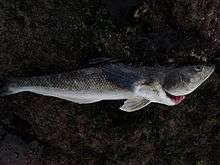Eleginops maclovinus
Eleginops maclovinus, the Patagonian blenny or rock cod, is a species of notothenioid fish[1] found in coastal and estuarine habitats around southernmost South America, ranging on half south of Chile on the Pacific side, and Argentina [2] on the Atlantic side.[3] It is also found around the Malvinas Islands, where it has been featured on a stamp.[4] It is the only member of its genus, which is the only member of the family Eleginopsidae.[5] Its English names refer to the vaguely blenny-, mullet-, or cod-like appearance, but it is not related to true blennies, mullets, or cods. Locally, it is often called róbalo,[6] a name also used for the common snook.
| Eleginops maclovinus | |
|---|---|
 | |
| Eleginopidae | |
| Scientific classification | |
| Kingdom: | |
| Phylum: | |
| Class: | |
| Order: | |
| Suborder: | |
| Family: | Eleginopsidae T. N. Gill, 1893 |
| Genus: | Eleginops T. N. Gill, 1862 |
| Species: | E. maclovinus |
| Binomial name | |
| Eleginops maclovinus (G. Cuvier, 1830) | |
| Synonyms | |
| |
It is commonly fished in parts of its range.[7] It is an omnivore, tending towards carnivore. In some parts of its range, it is especially fond of Paracorophium,[6] but it is opportunistic, and its exact diet depends on the availability in the habitat where the individual fish lives.[3]
It reaches about 105 cm (3.44 ft) in length, and can live for 10 years.[3] It is a protandric hermaphrodite, and males predominate in lengths below 52 cm (1.71 ft), while female predominate above.[8] It has a diploid number of 48, and a fundamental number of 54.[5]
Religious significance to the indigenous people
The abundant and nutritious patagonian blenny were apparently not consumed in Tierra del Fuego and the rock art suggests they may have had some religious significance.[9]
See also
References
- http://www.fishbase.org/summary/Eleginops-maclovinus.html
- "Eleginops maclovinus (Róbalo Patagónico, Bacalao Austral - Patagonian Blennie) | SIB, Parques Nacionales, Argentina". Sistema de Información de Biodiversidad (in Spanish). Retrieved 2020-07-18.
- Licandeo, Barrientos and González (2006). Age, Growth Rates, Sex Change and Feeding Habits of Notothenioid Fish Eleginops Maclovinus from the Central-southern Chilean Coast. Environmental Biology of Fishes 77(1): 51-61
- WoRMS (2009). Falkland Island Stamps.
- Mazzei, Ghigliotti, Coutanceau, Detrich, Prirodina, Ozouf-Costaz and Pisano (2008). Chromosomal characteristics of the temperate notothenioid fish Eleginops maclovinus (Cuvier). Polar Biology 31(5): 629-634
- Pavés, Pequeño, Bertrán and Vargas (2005). Limnetic feeding in Eleginops maclovinus (Valenciennes, 1830) in the Valdivia River, Chile. Interciencia 30(3): 120-125.
- Quiñones and Montes (2001). Relationship between freshwater input to the coastal zone and the historical landings of the benthic/demersal fish Eleginops maclovinus in central-south Chile. Fisheries Oceanography 10(4): 311–328
- Brickle, Laptikhovsky and Arkhipkin (2005). Reproductive strategy of a primitive temperate notothenioid Eleginops maclovinus. Journal of Fish Biology 66(4): 1044-1059
- Fiore, Danae; Francisco, Atilio; Zangrando, J. (2006). "Painted fish, eaten fish: Artistic and archaeofaunal representations in Tierra del Fuego, Southern South America". Journal of Anthropological Archaeology. 25 (3): 371–389. doi:10.1016/j.jaa.2006.01.001.